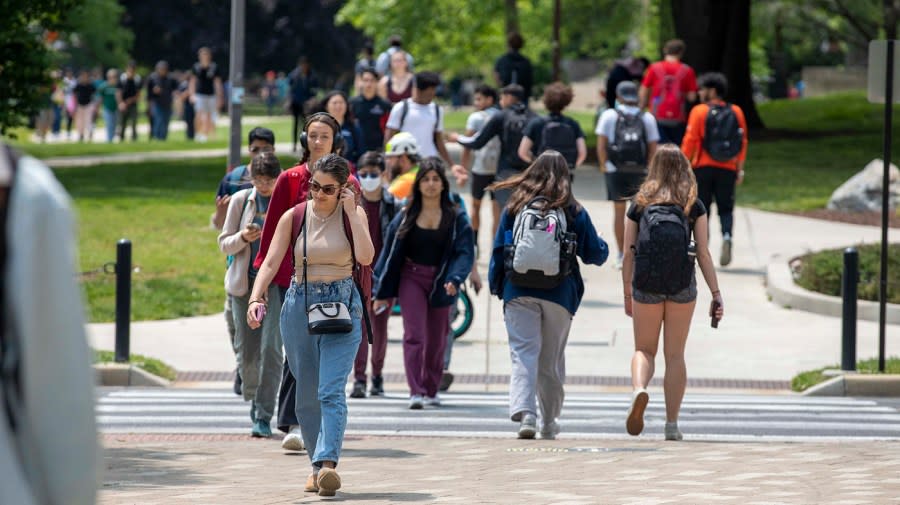FAFSA, job market pose major challenges for colleges despite enrollment gains

Colleges have seen a recent uptick in enrollment, but a variety of factors — from changes in the employment market to this year’s Free Application for Federal Student Aid (FAFSA) mess — mean the signs of hope could be short-lived.
The National Student Clearinghouse Research Center released data this month showing an increase in enrollment this spring, but the numbers are still below prepandemic levels, as universities face a tumultuous future amid changing job requirements and demographic troubles.
Undergraduate enrollment peaked in 2010 with around 18.1 million students. By 2021, during the height of the pandemic, it had fallen to 15.4 million.
“Whether it’s a fluke or not, there are a lot of factors that are indicating that the downward trend may well continue,” said Stephen Henn, adjunct professor of economics at Sacred Heart University.
The report found undergraduate enrollment went up 2.5 percent this spring, the second annual increase in a row after years of declines.
The most immediate issue that could affect those gains in the fall are this year’s FAFSA forms. While the FAFSA season typically begins in October, the applications weren’t available until January. From there, numerous delays occurred, from issues with the website to incorrect amounts of aid sent to students.
“What we are concerned about right now is the FAFSA,” said Catherine Brown, senior director of policy and advocacy at the National College Attainment Network (NCAN), adding that the difficulties for applicants could translate into “a problem for fall enrollment.”
As of May 17, the NCAN found 41.5 percent of the high school class of 2024 has completed their FAFSA forms, down 15.5 percent compared to last year.
Those “significant” declines, Brown said, are even “worse in high schools serving high populations of students of color and students from low-income communities.”
But much bigger long-term problems for universities looking to boost their numbers are the shifts in the employment market and how students — and employers — view the necessity of degrees.
The job posting site Indeed released data in February showing 52 percent of its listings had no formal education requirement. In the past four years, job postings with no degree requirement went up 4 percent.
“What we’ve seen is that educational requirements are gradually disappearing from job postings,” said Cory Stahl, an economist at the Indeed Hiring Lab.
“It doesn’t necessarily surprise me is that in the last several years … we’ve seen kind of a growing support for skills-based hiring, and that’s something that we’ve noticed that employers are becoming much more explicit, much more willing to list is the skills in our job postings, rather than just ‘let’s put a degree requirement on this,’” Stahl said.
With a wider variety of degree-free employment opportunities available to them as college costs continue to soar, advocates say fewer students feel the need to take on so much debt in order to earn a cap and gown.
And the drop in education requirements isn’t reserved for the private sector, either.
Multiple states such as Maryland have said they would be dropping degree requirements for thousands of government jobs.
“Through these efforts we are launching today, we are ensuring that qualified, non-degree candidates are regularly being considered for these career-changing opportunities,” then-Gov. Larry Hogan (R) said at the time.
Other challenges to enrollment that schools face are even less under their control.
“Demographically, the birth rate, the general birth rates in the U.S. has been declining — as it has in most industrial countries — so that you’re going to see less, less students of college age come in. And I think the overall demographics will continue to go down unless they are replaced by other college students, like immigrants,” Henn said.
And where students choose to study is also shifting. Community colleges made up half of the increase in enrollment, according to the report from the National Student Clearinghouse, despite their numbers representing less than half of those enrolled in higher education.
“I think there’s [a] number of encouraging data points in and of itself; if you peel the onion a little bit further, then you can also see that vocational programs are driving a lot of the growth at the community college level,” said Michael Hansen, CEO at Cengage Group, one of the largest education technology companies in the world.
“I think students are asking, ‘Give me the skill sets that I can take to an employer so I can, you know, with a high probability, get a job and get a decent living and make more than I used to make before’ — that’s a good return on investment,” Hansen said. “So, that is being answered institution by institution. Some of them are being more active, more proactive, others are being a little bit lagging behind, but overall, I think we see the system moving. And I think that’s encouraging.”
Copyright 2024 Nexstar Media, Inc. All rights reserved. This material may not be published, broadcast, rewritten, or redistributed.
For the latest news, weather, sports, and streaming video, head to The Hill.

 Yahoo Finance
Yahoo Finance 